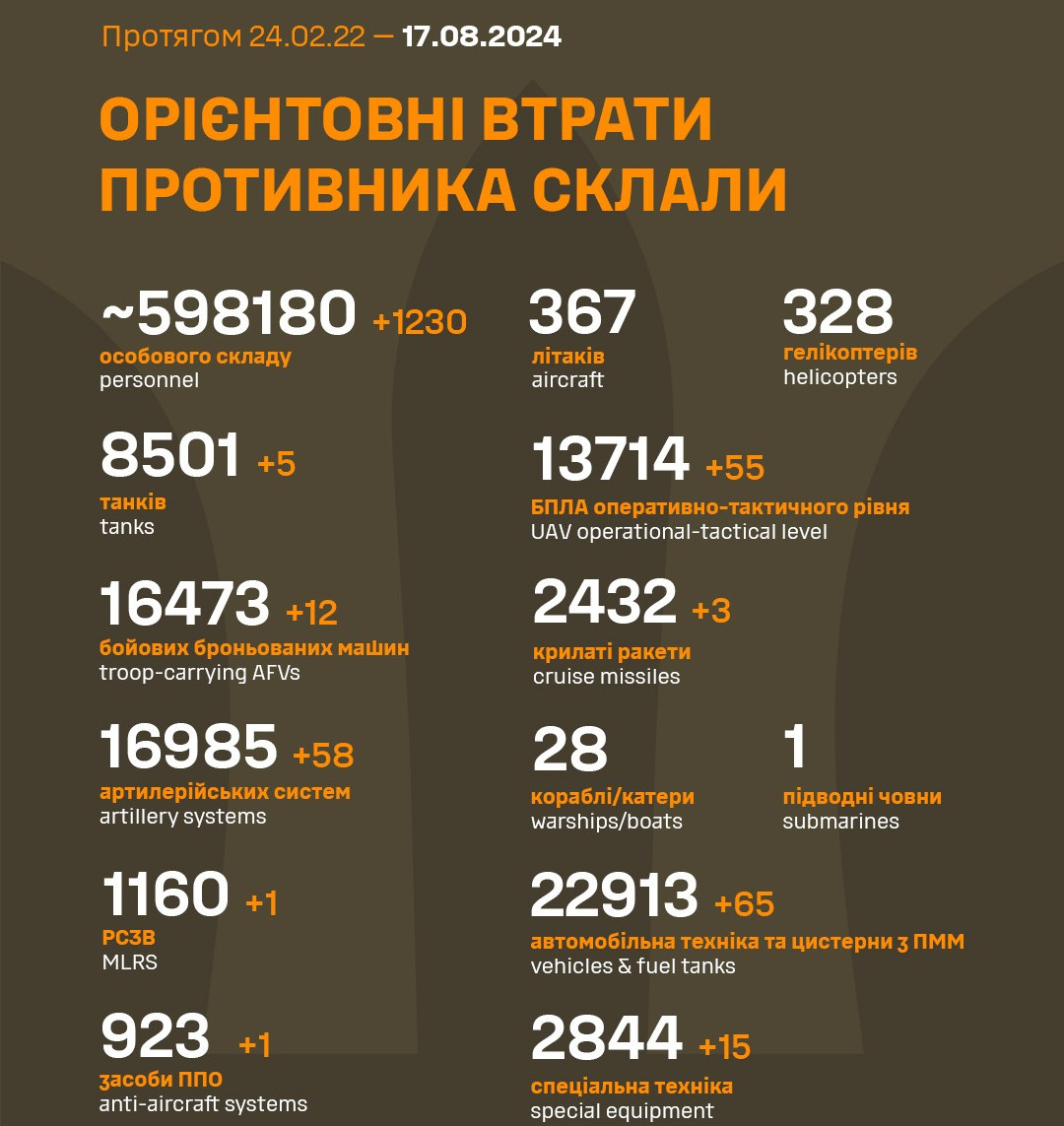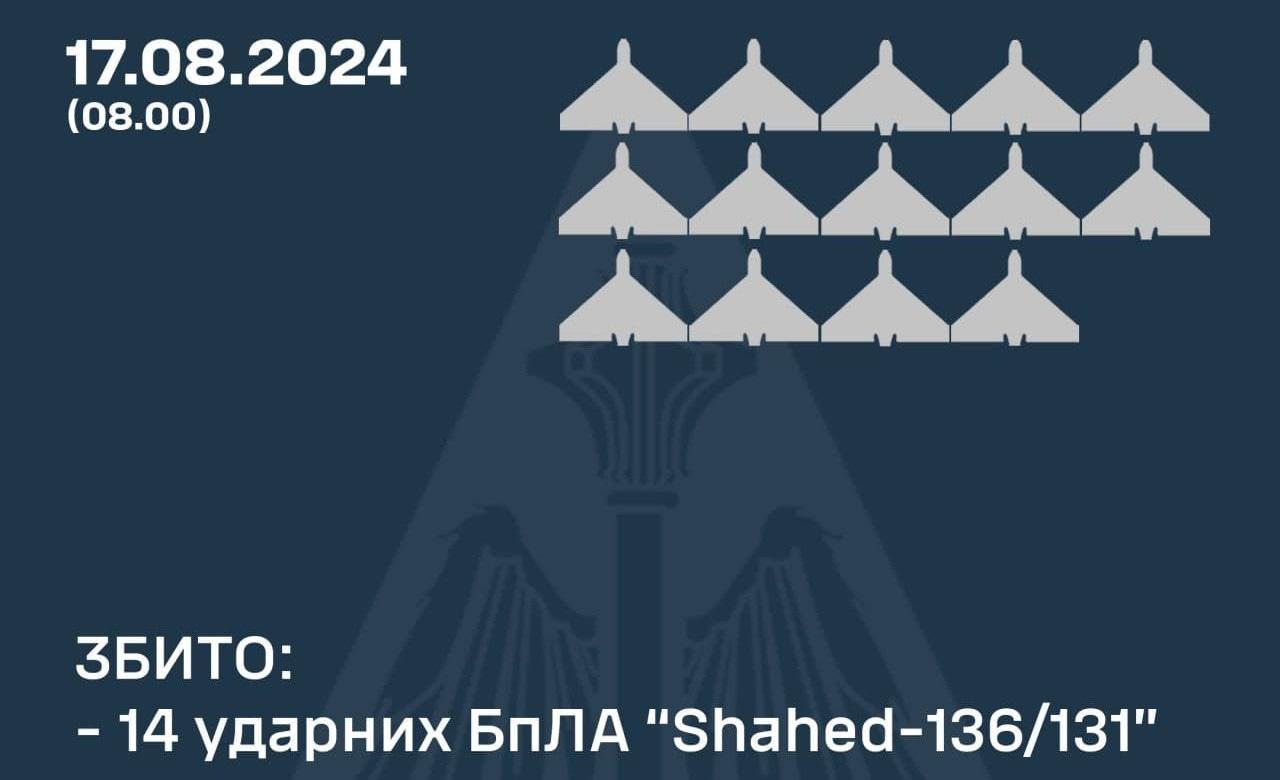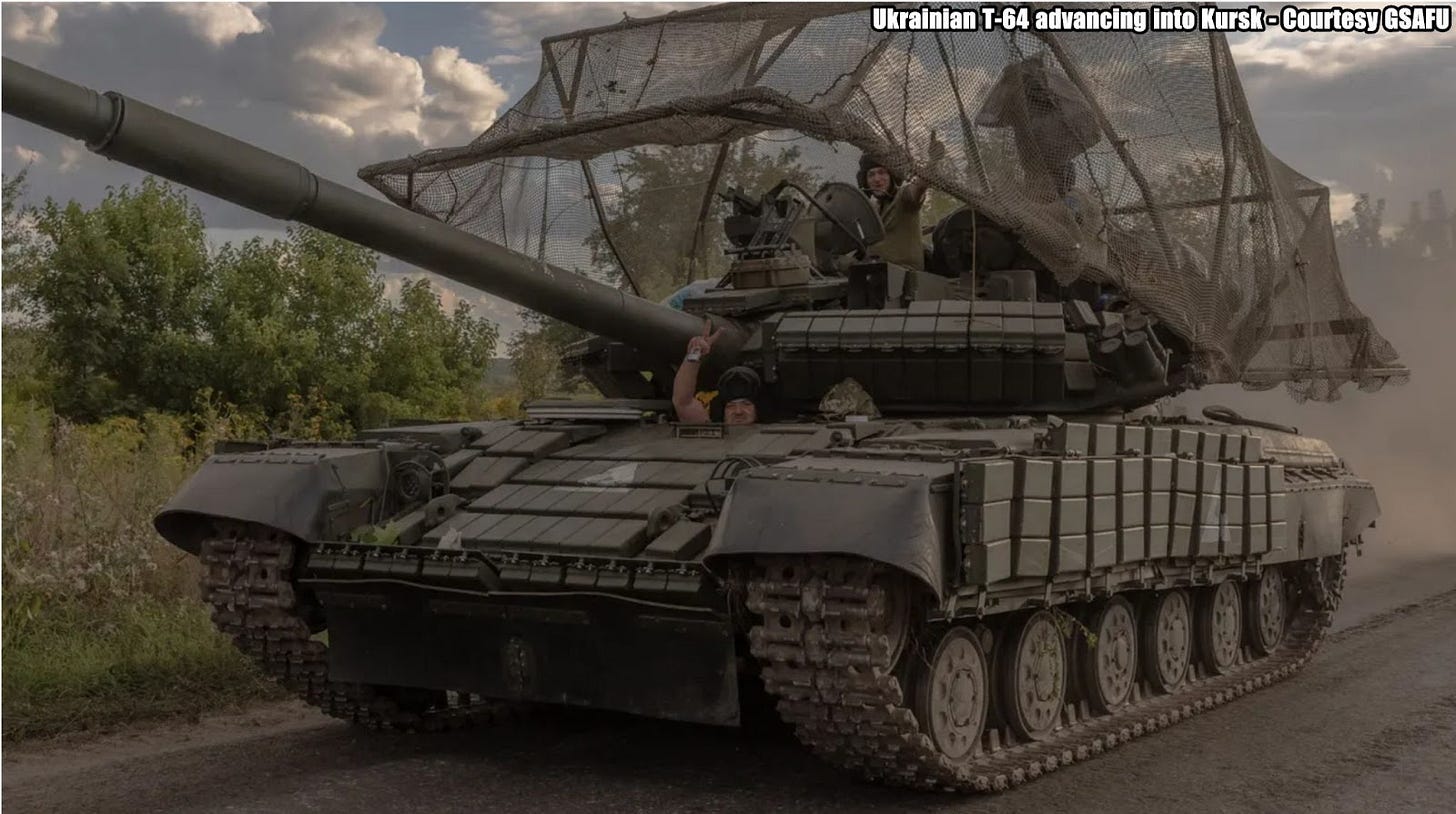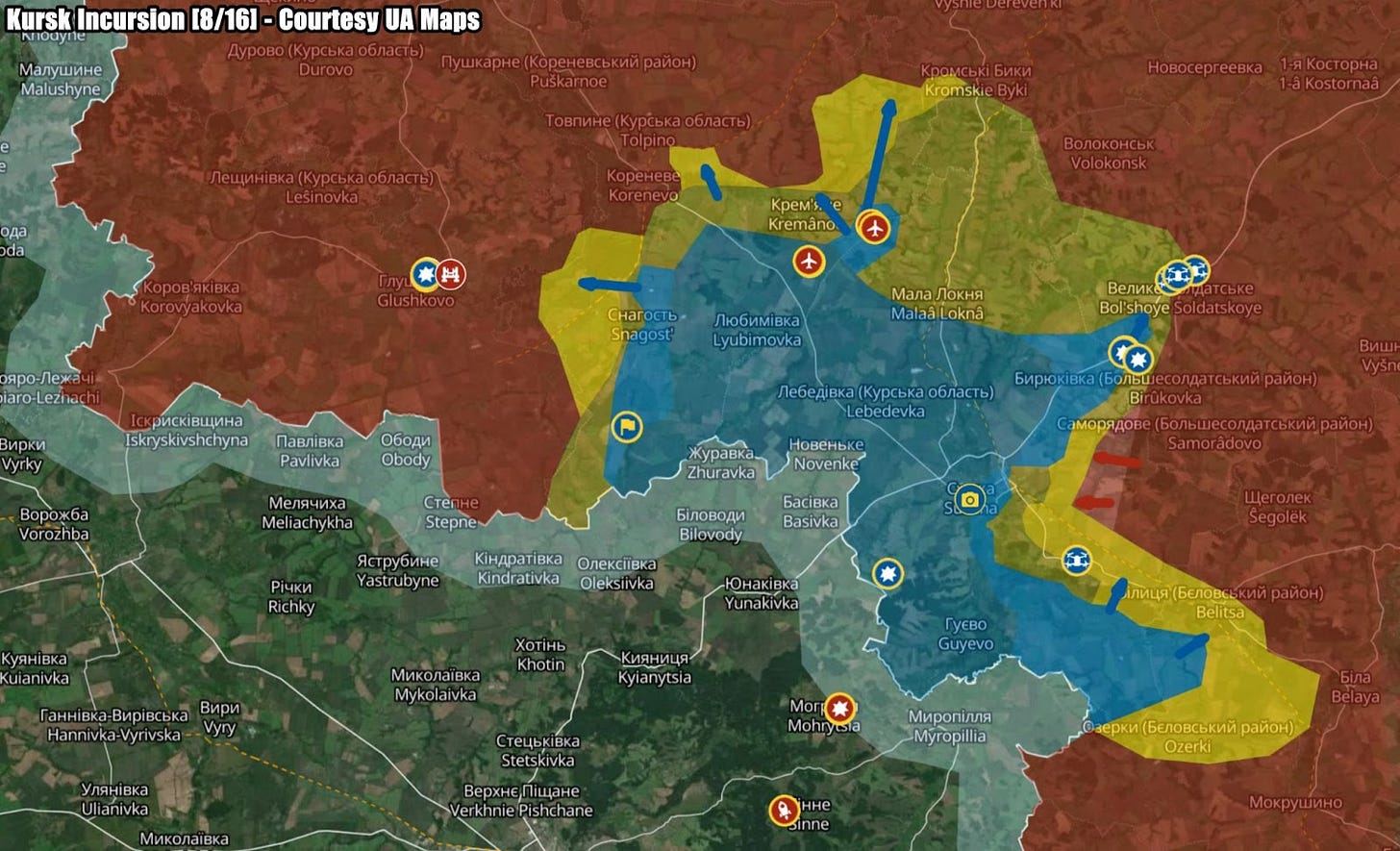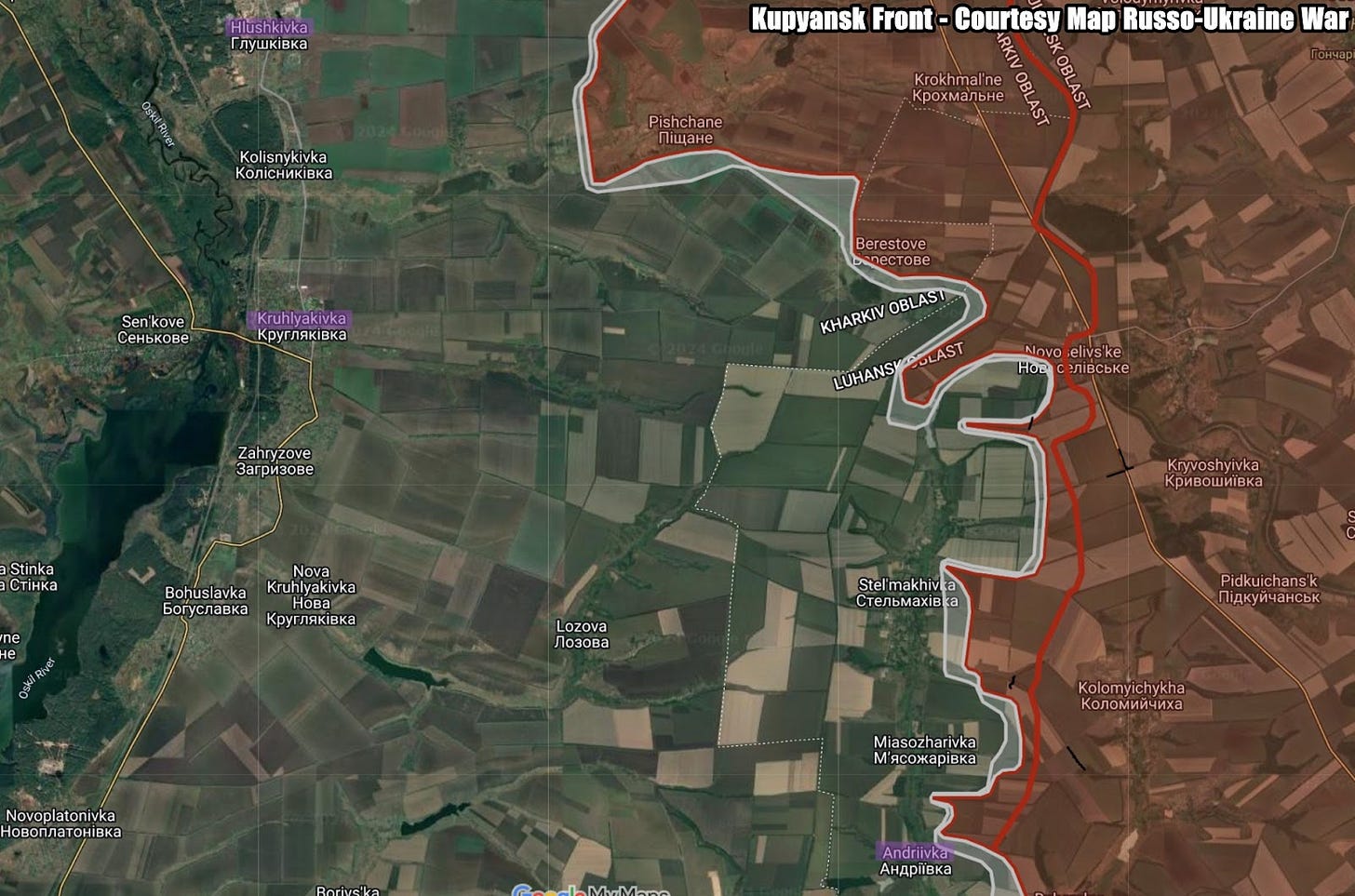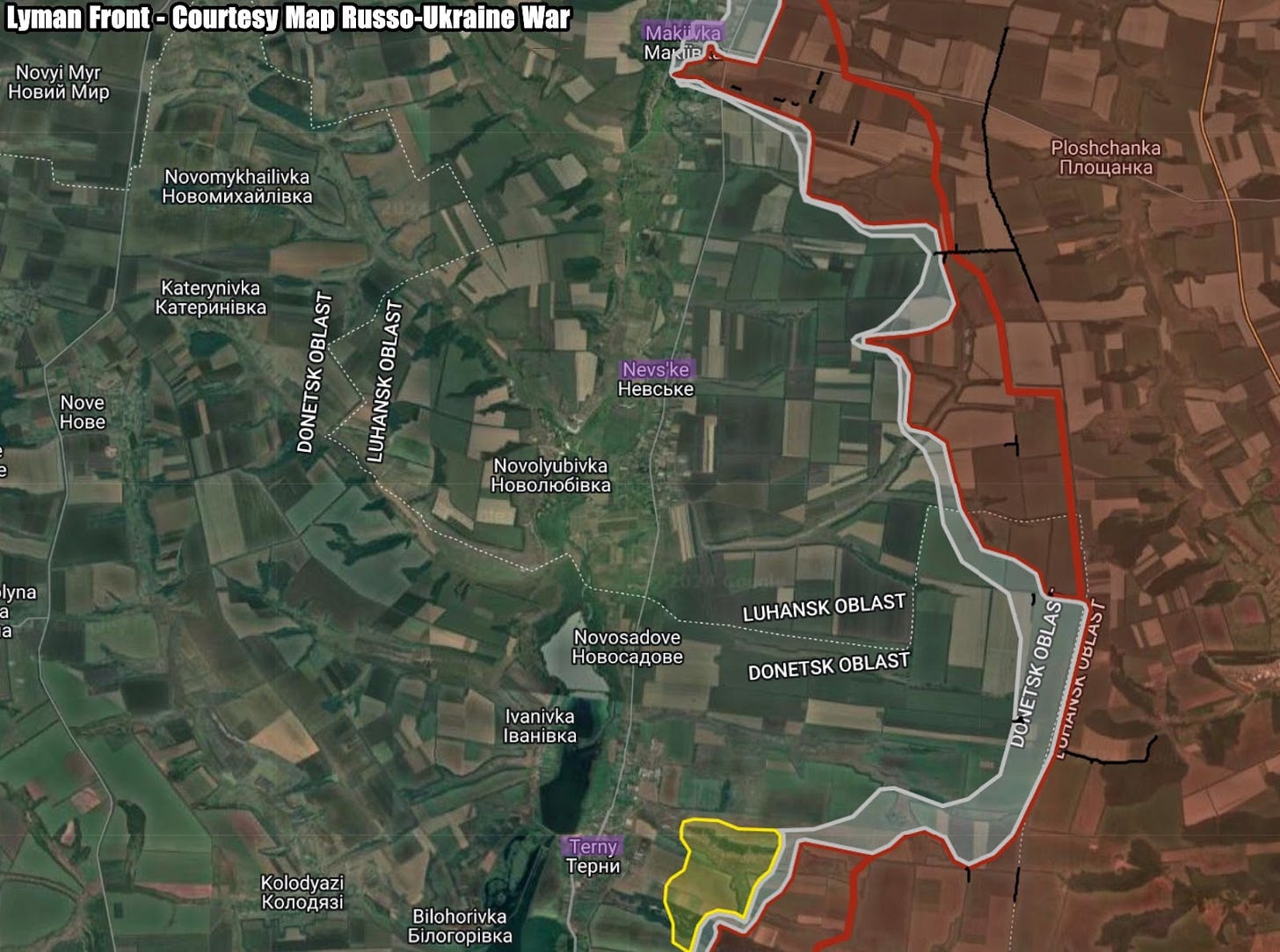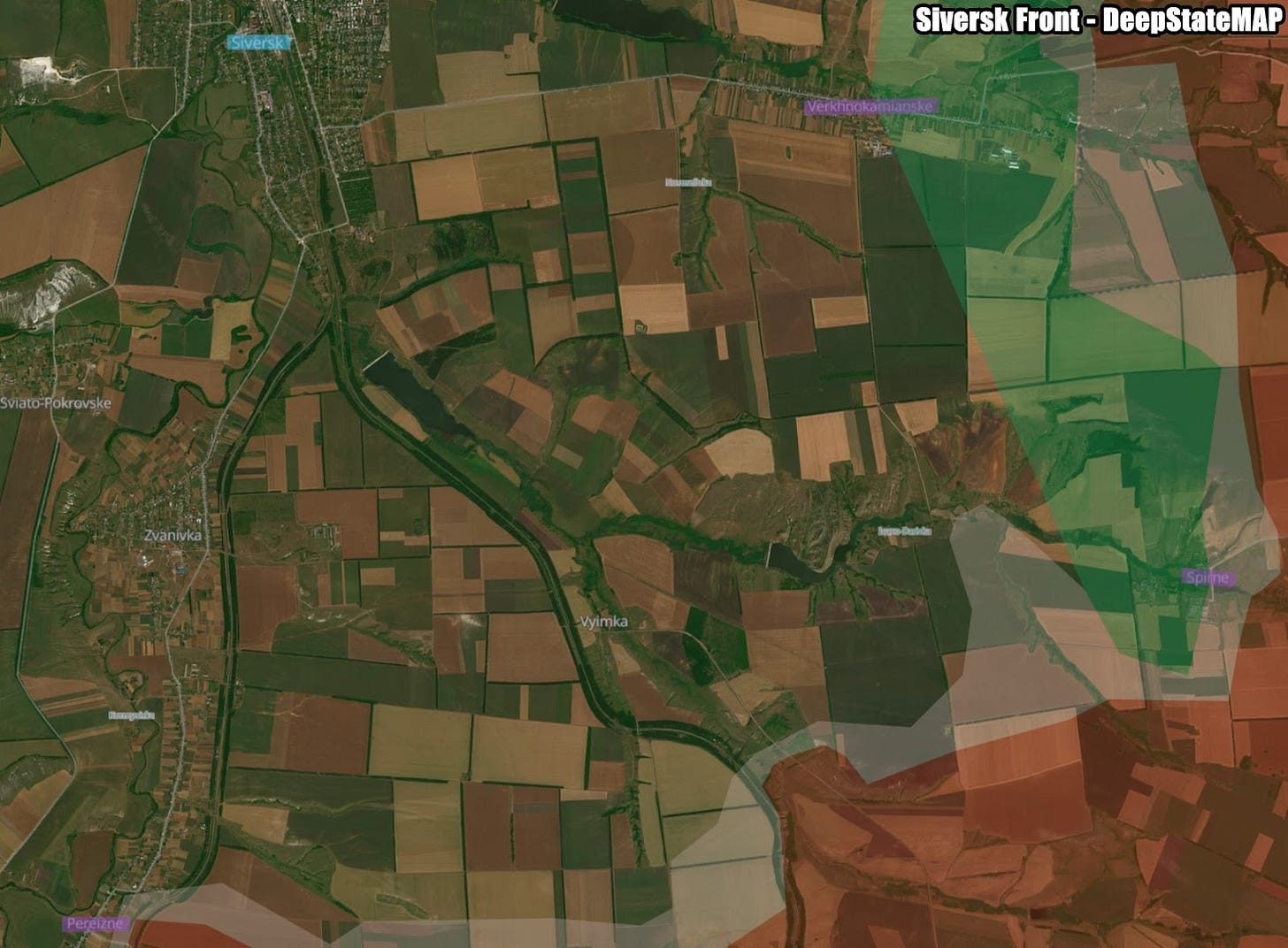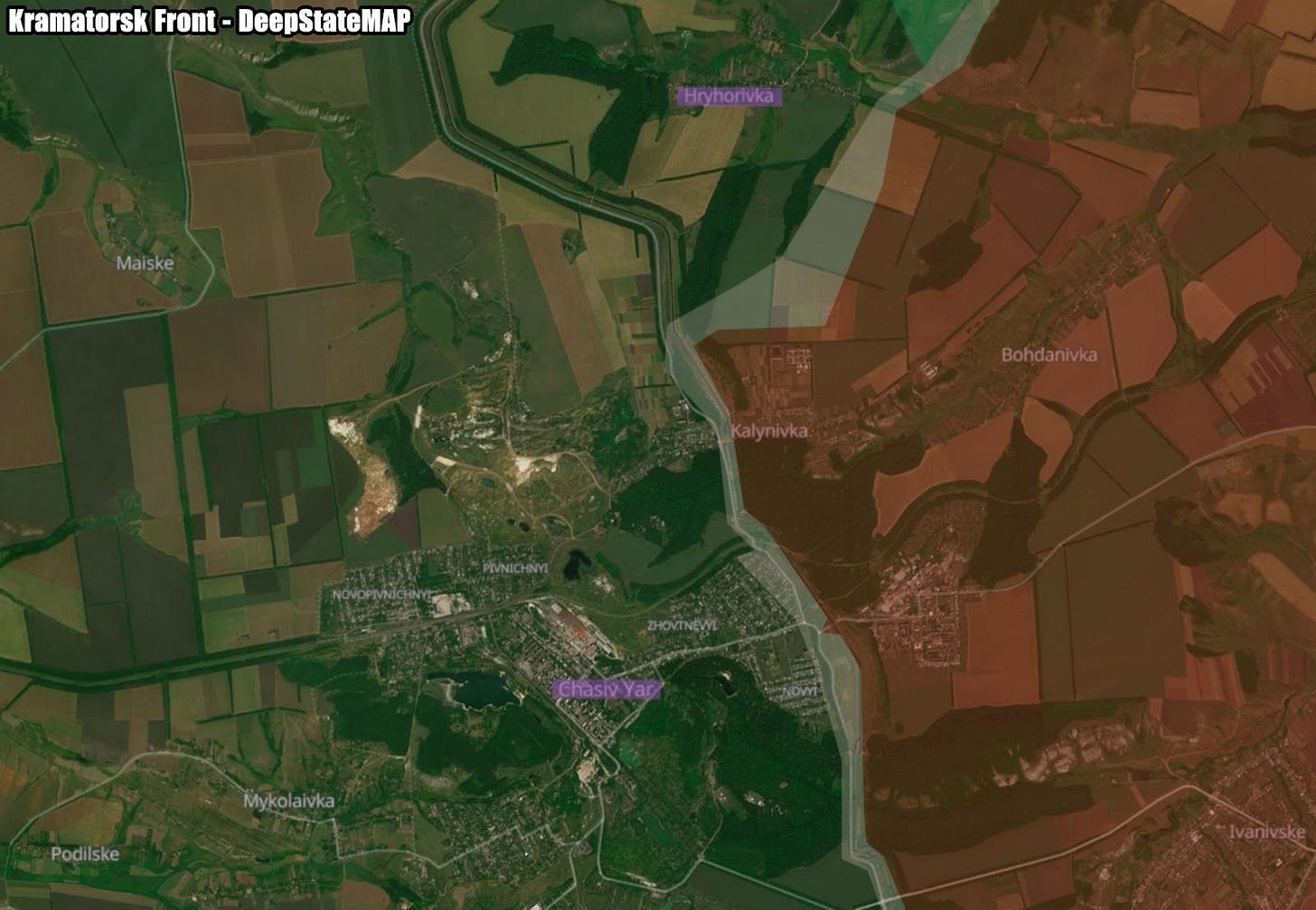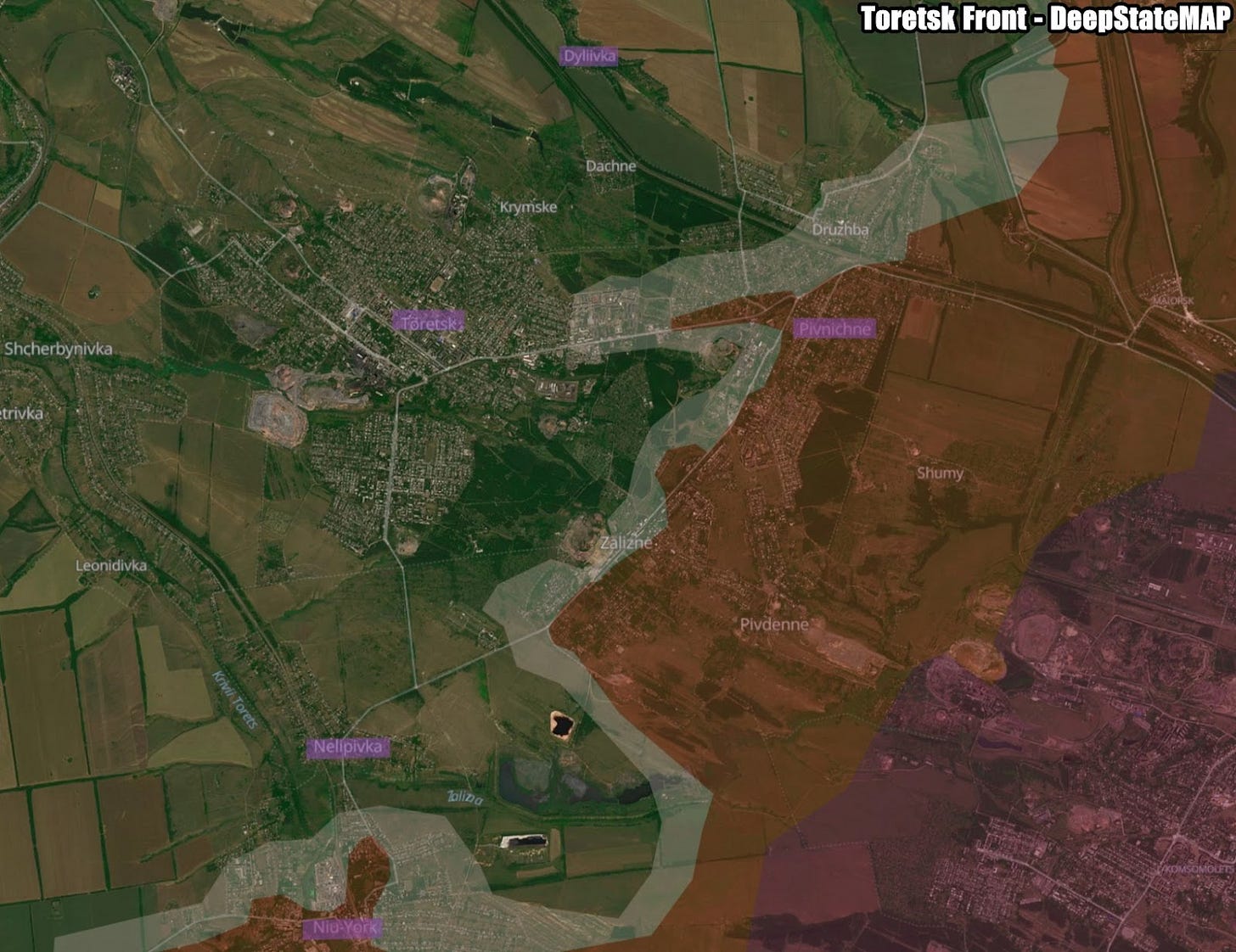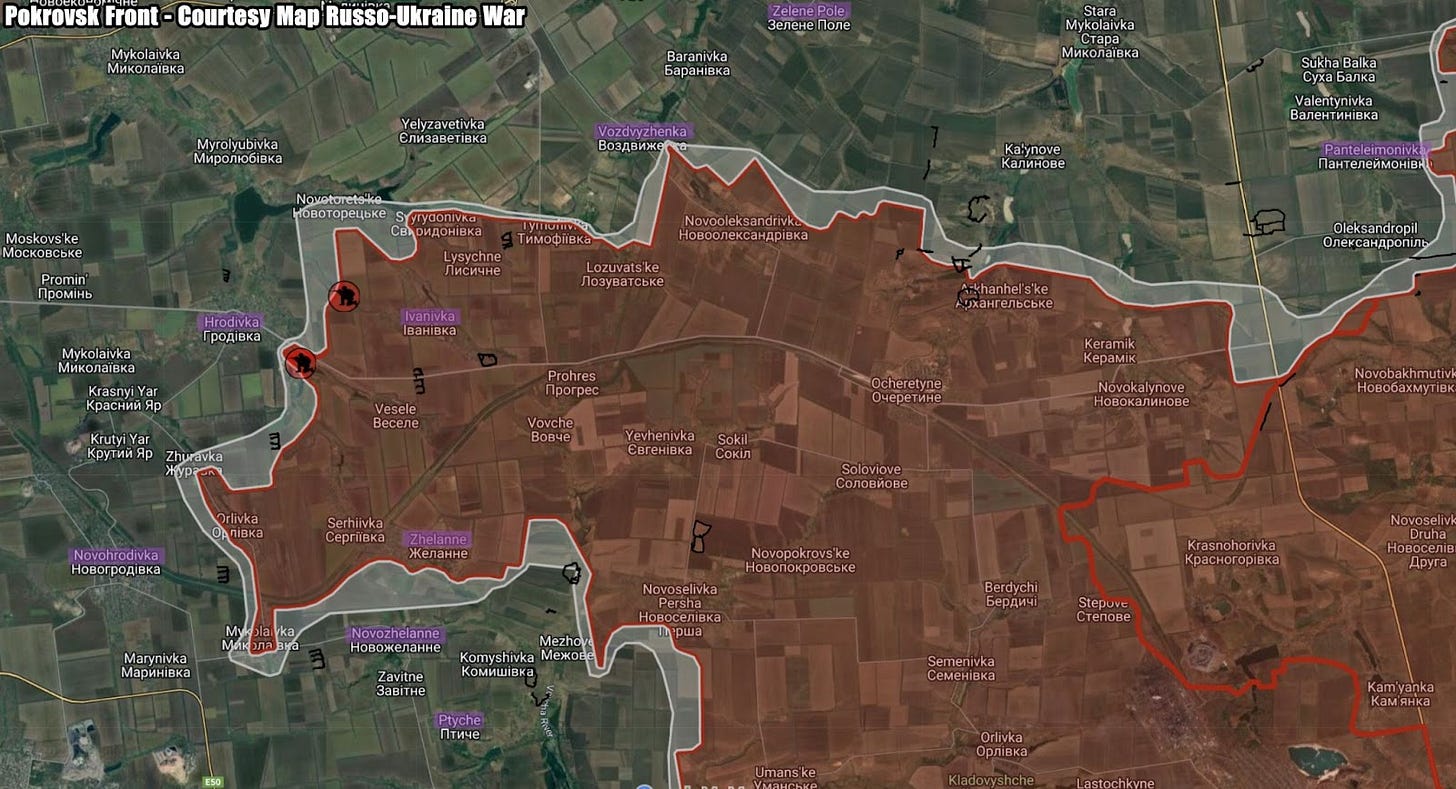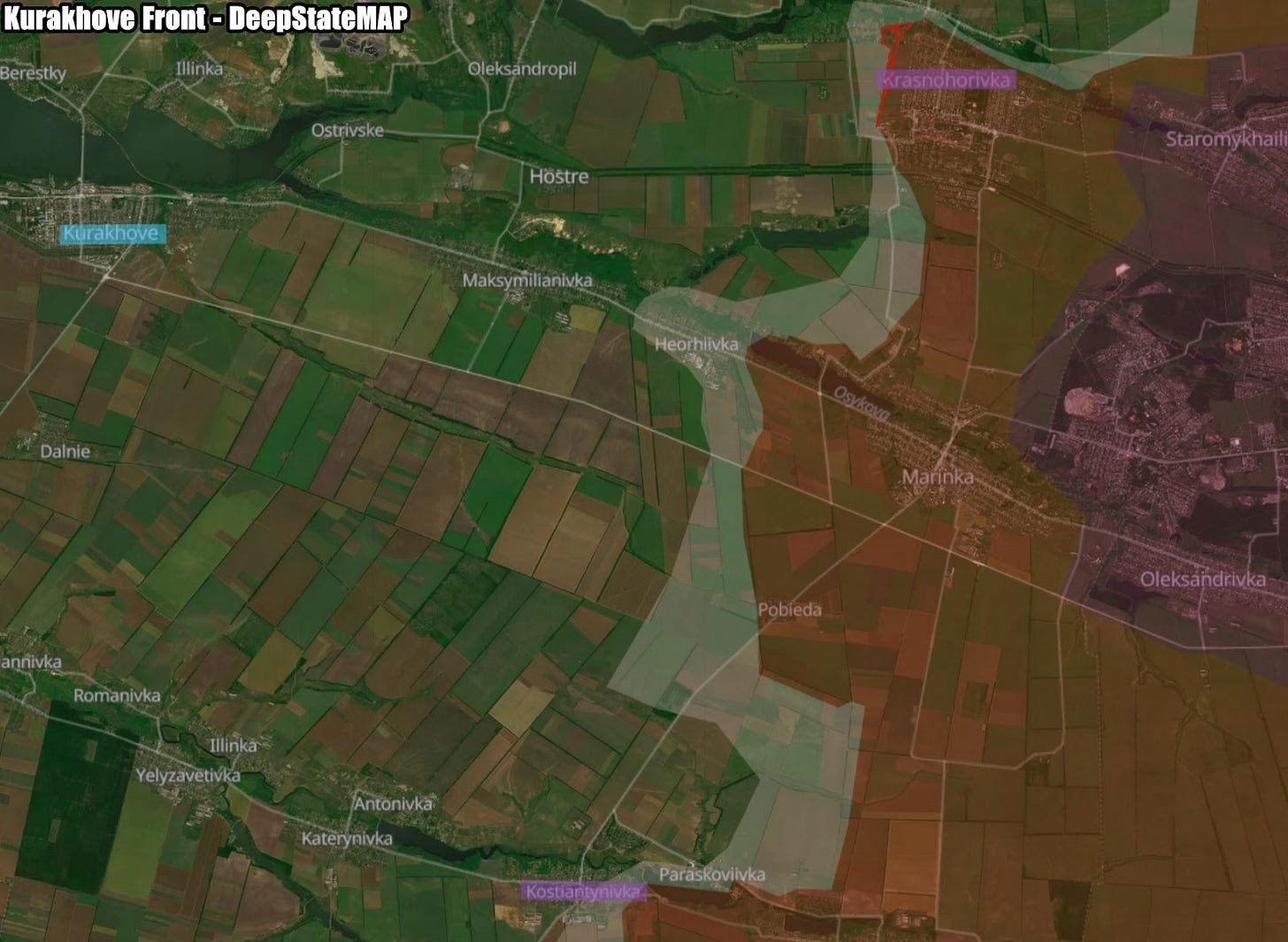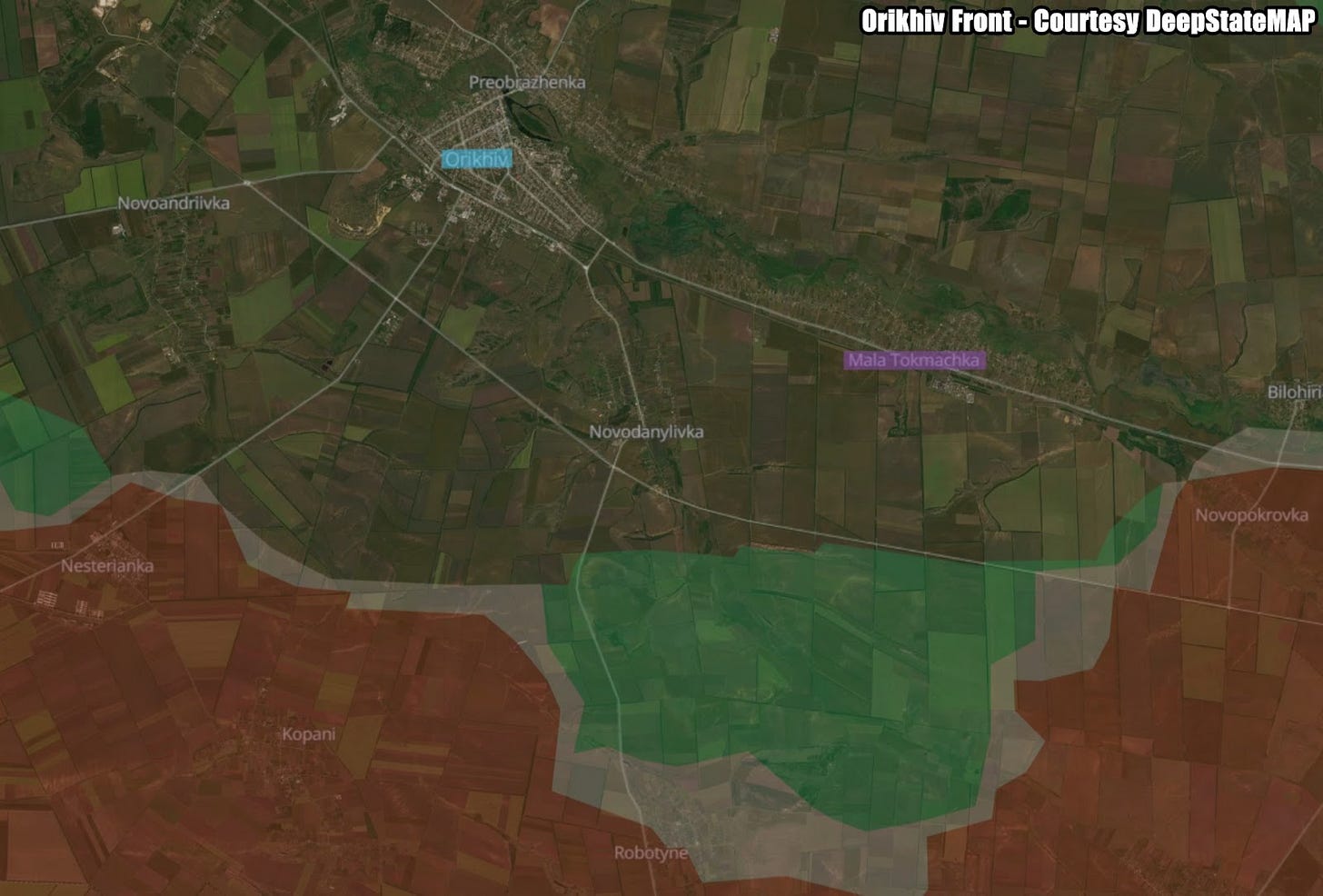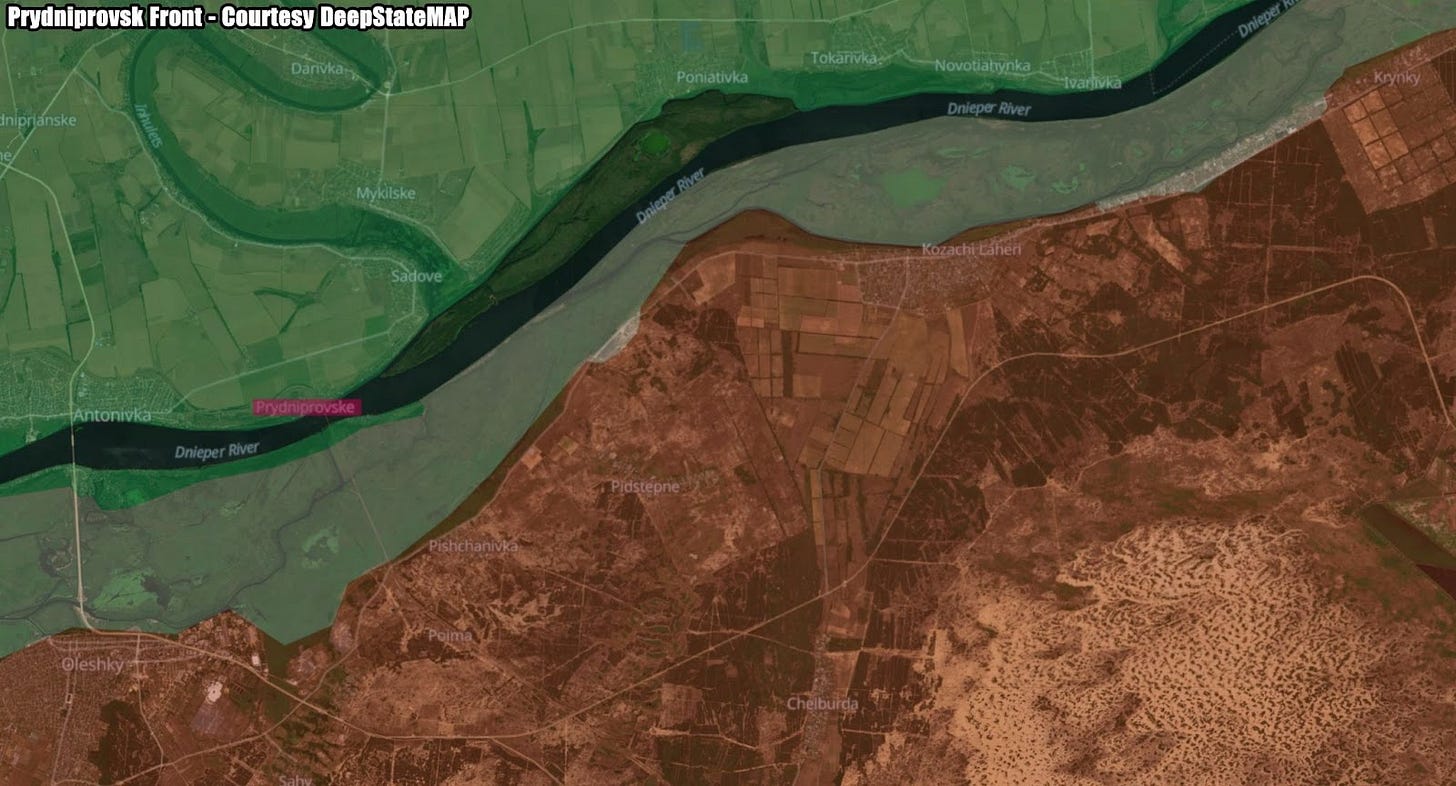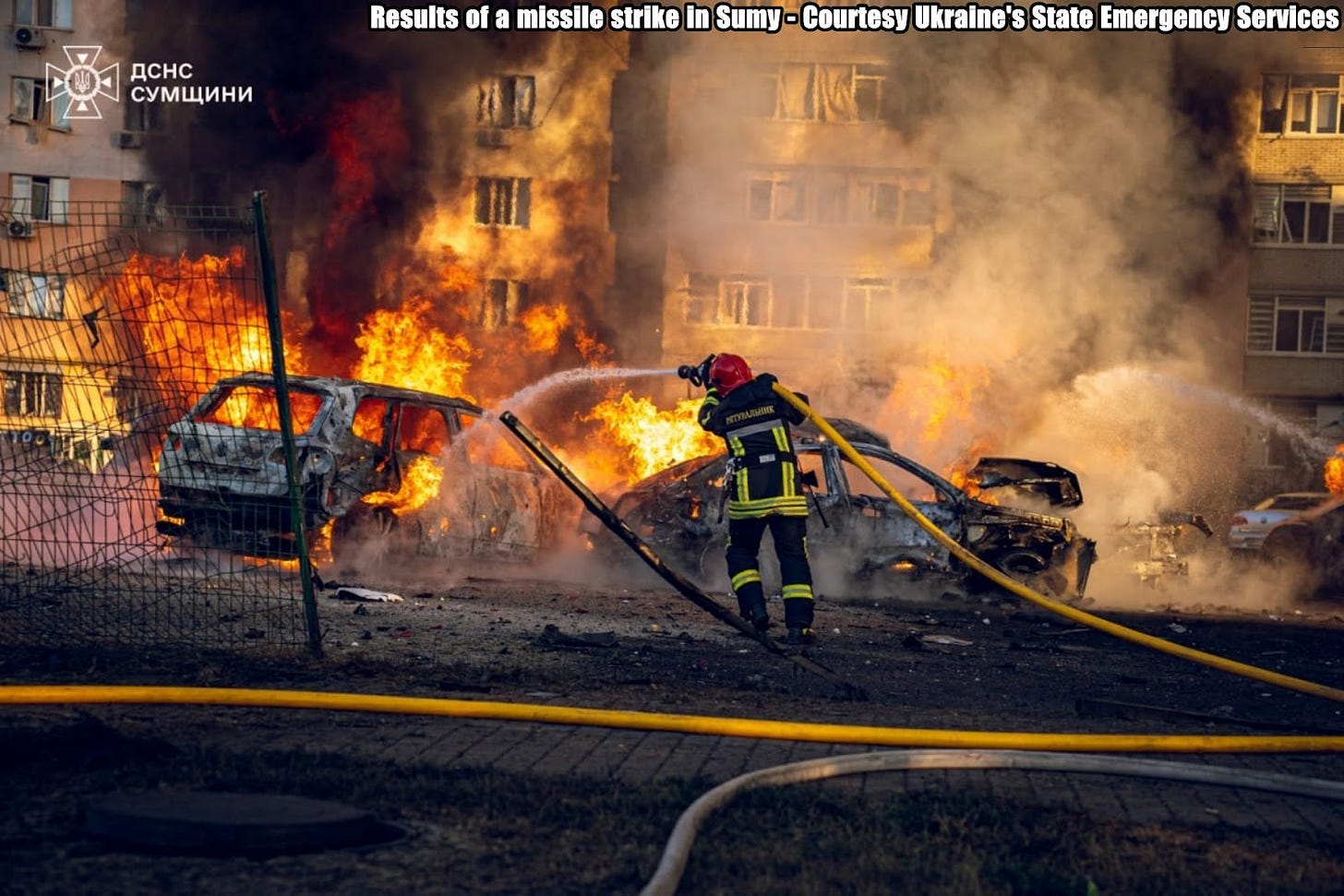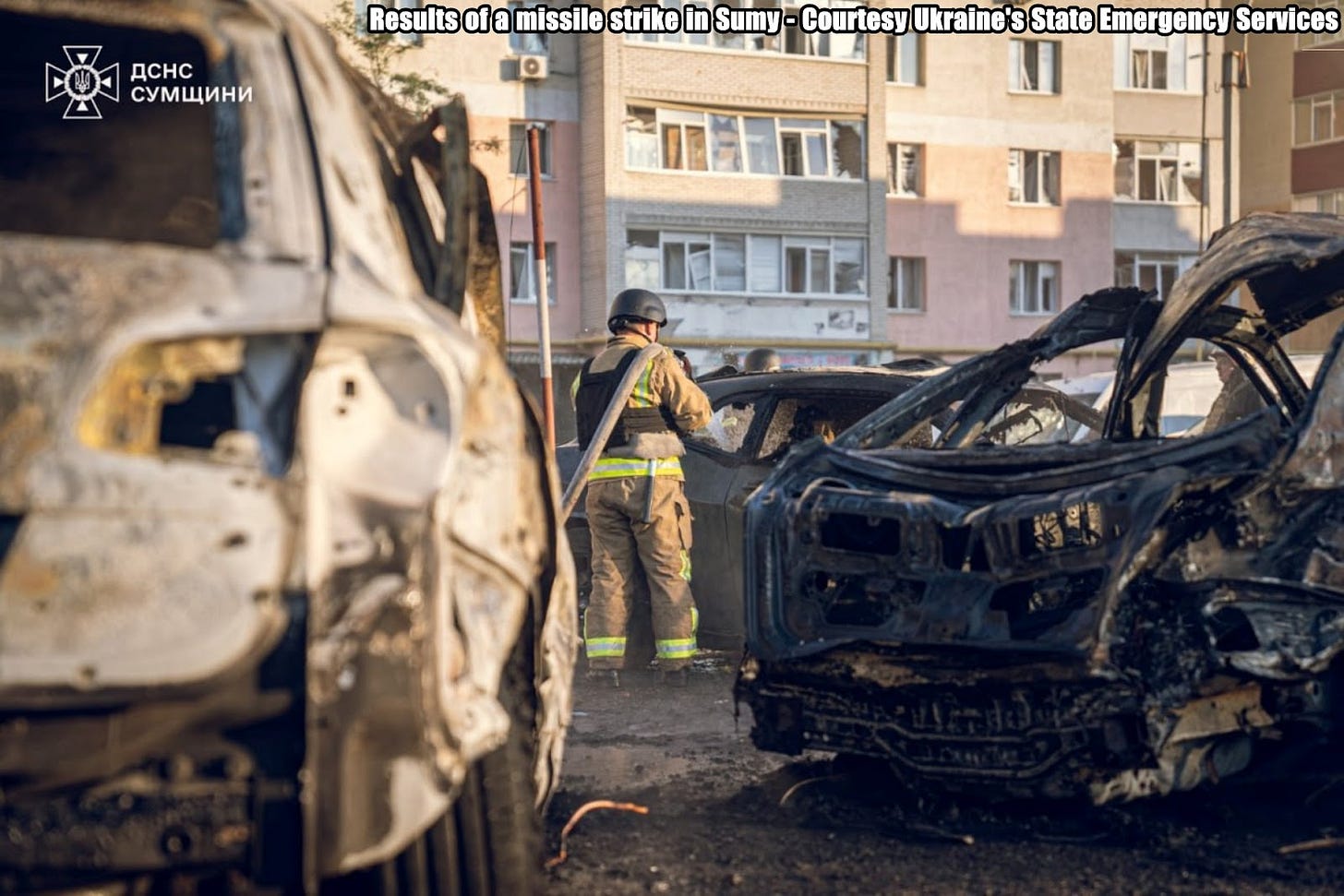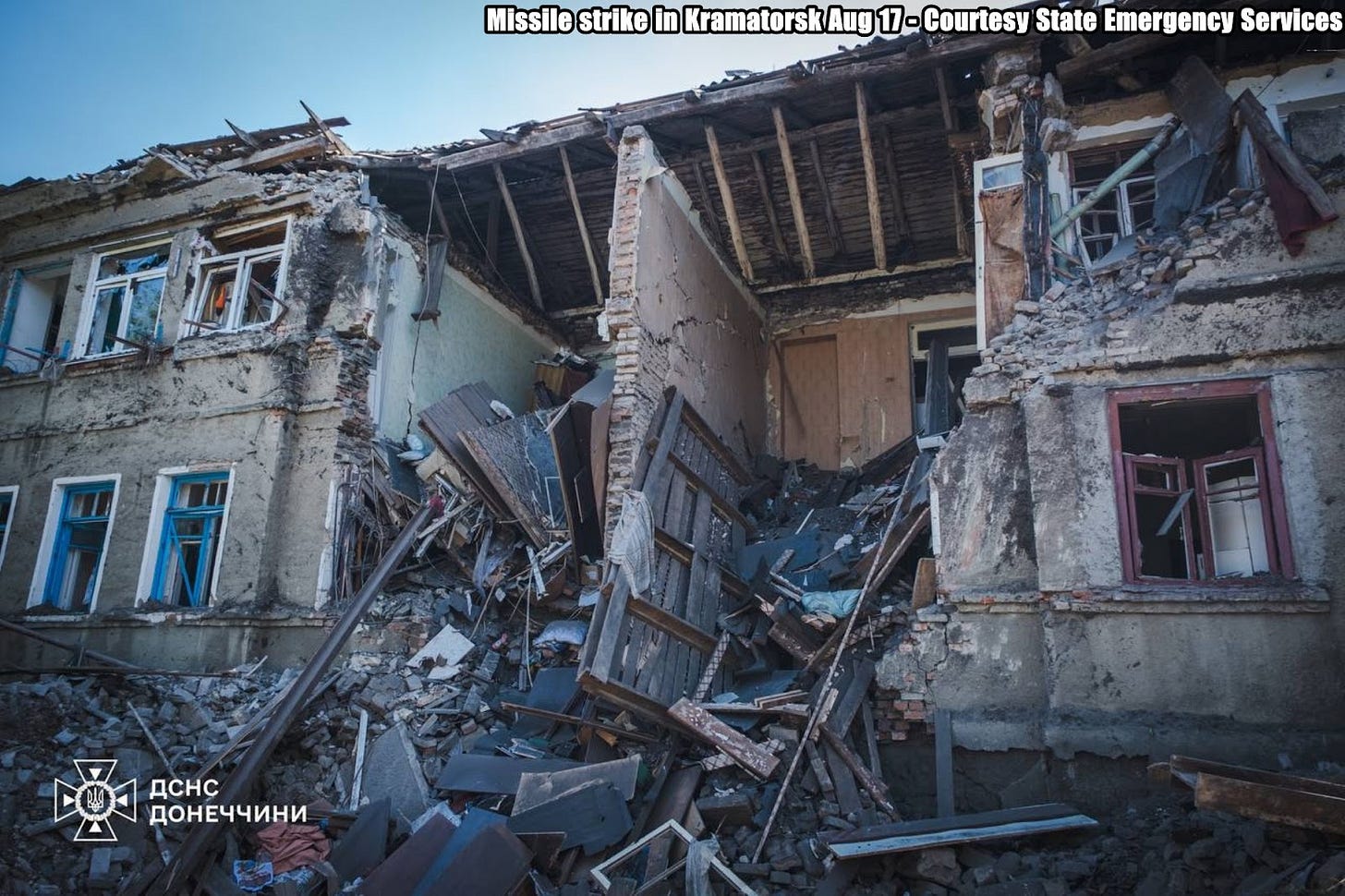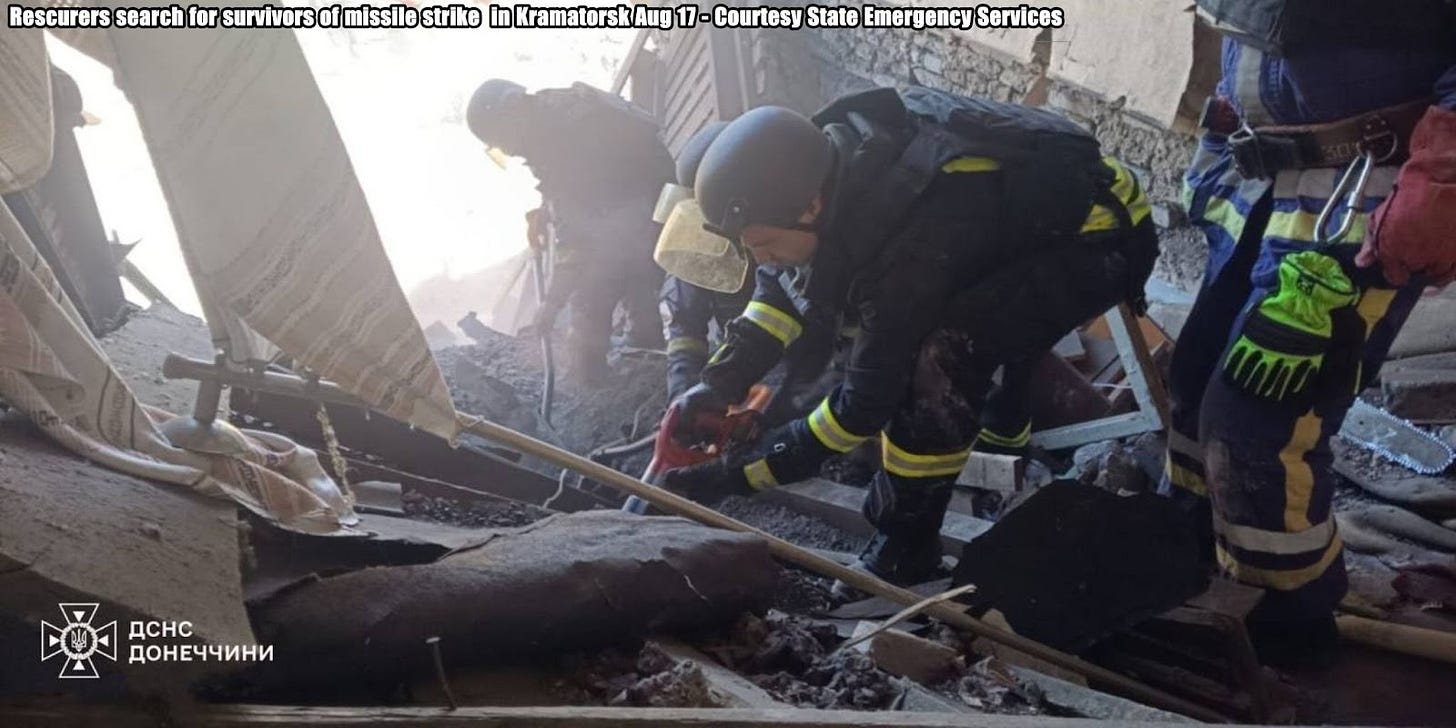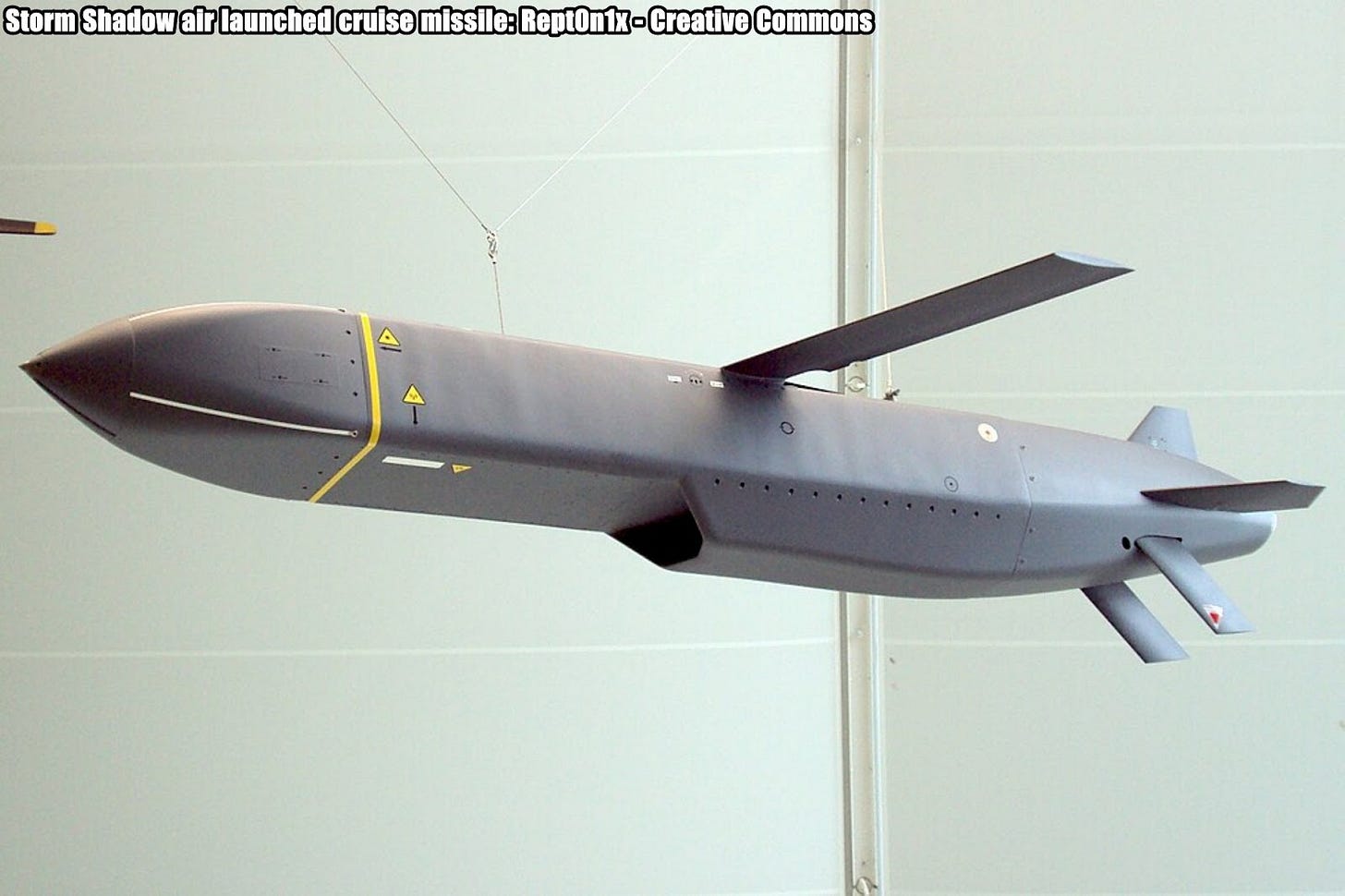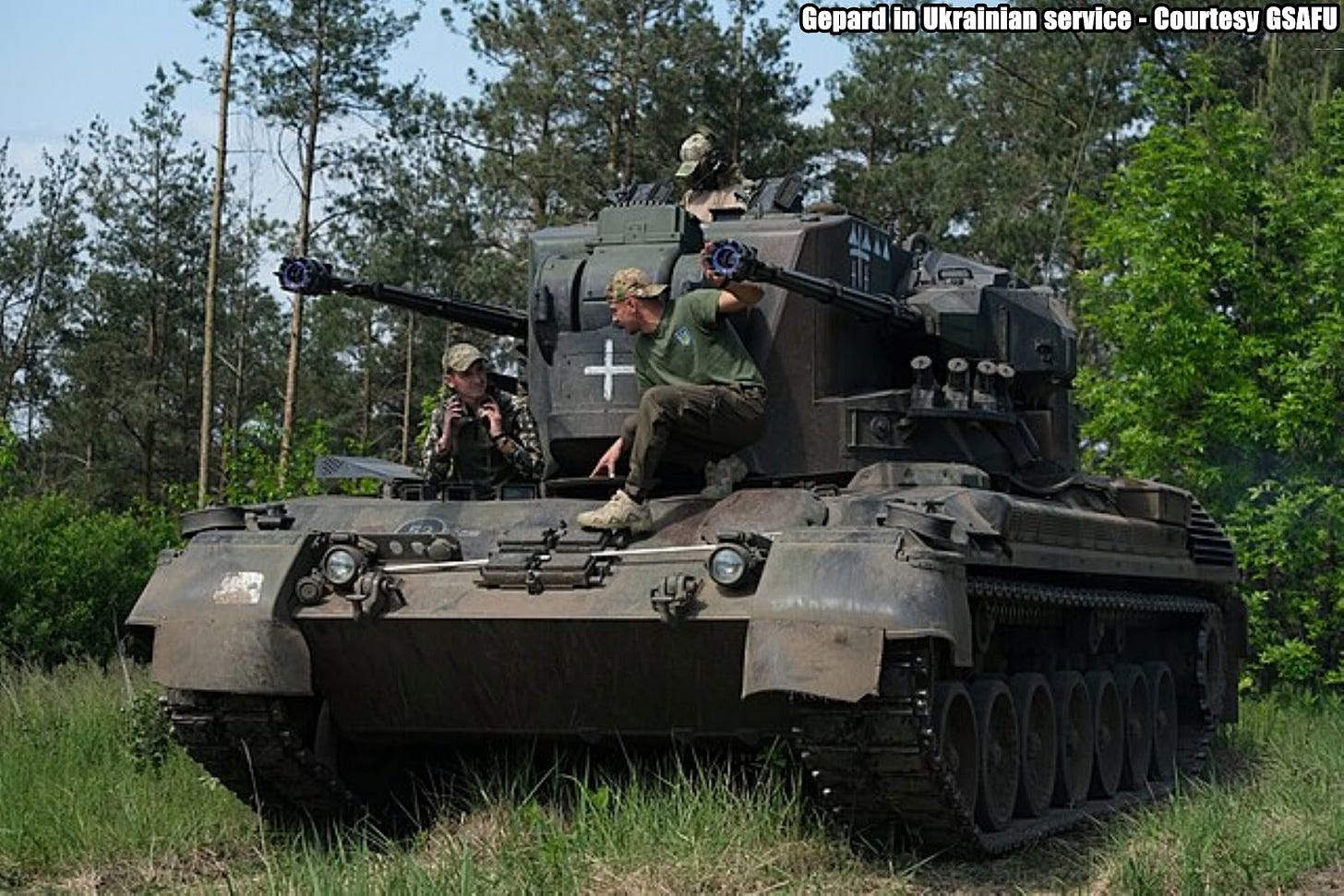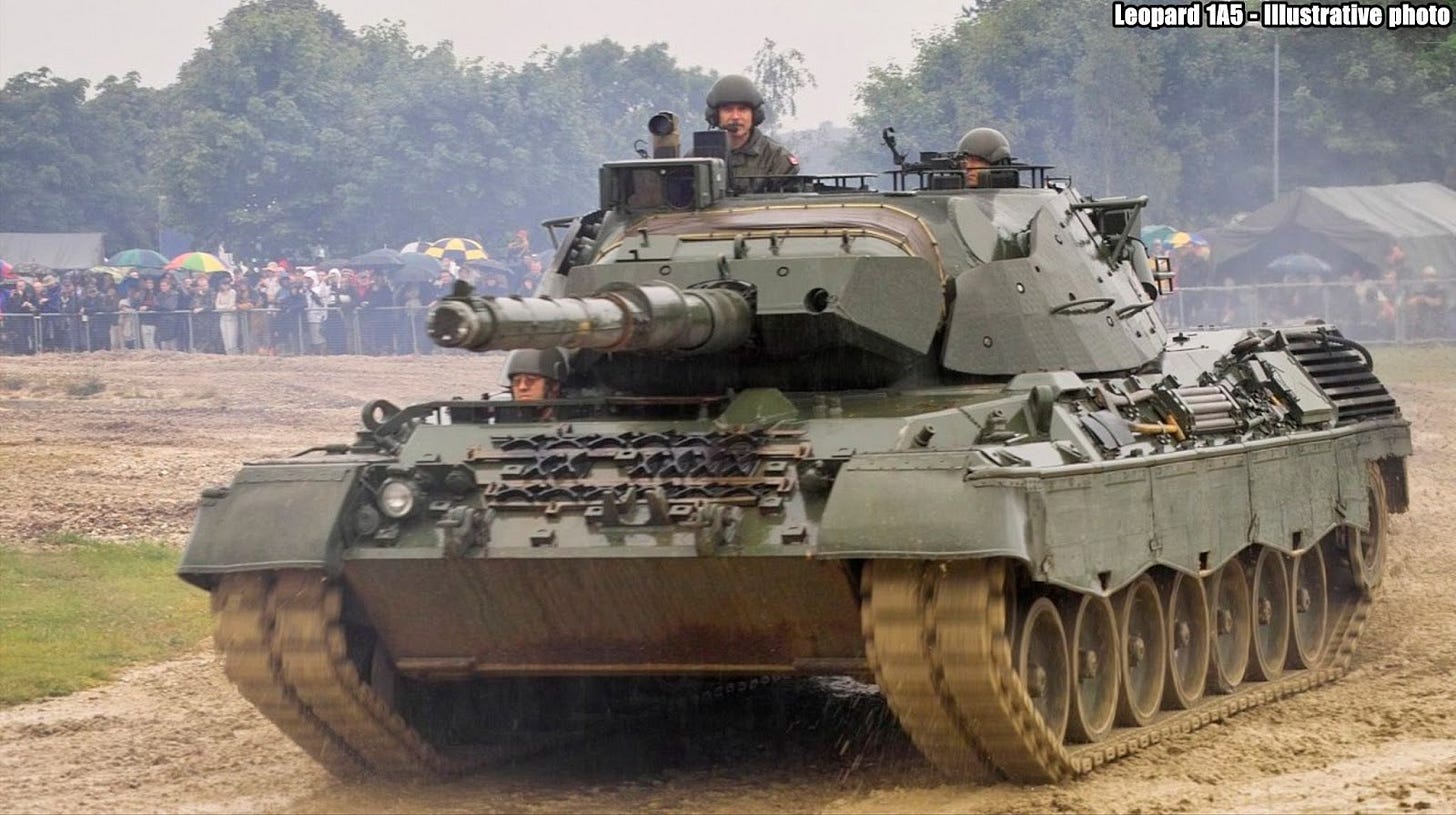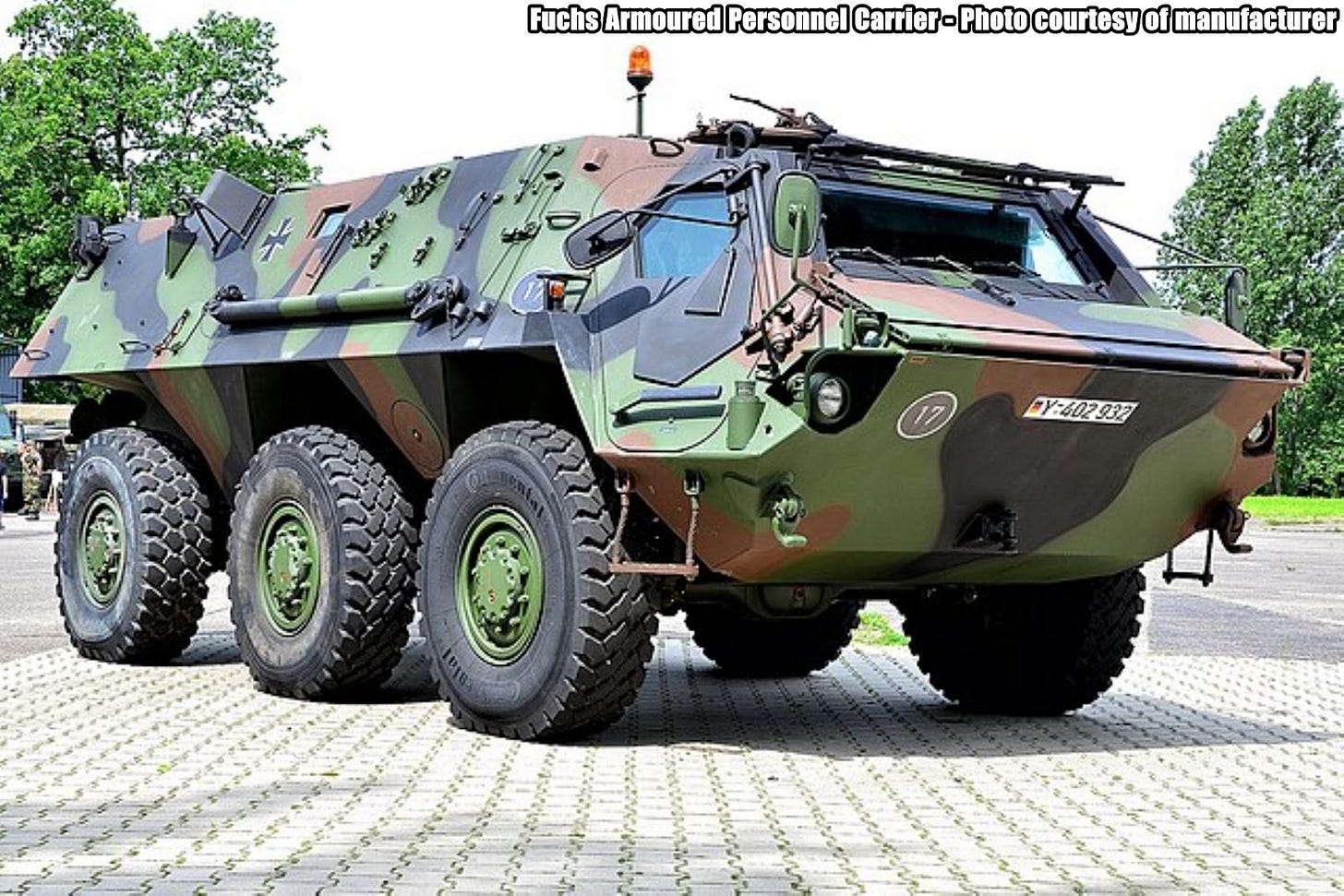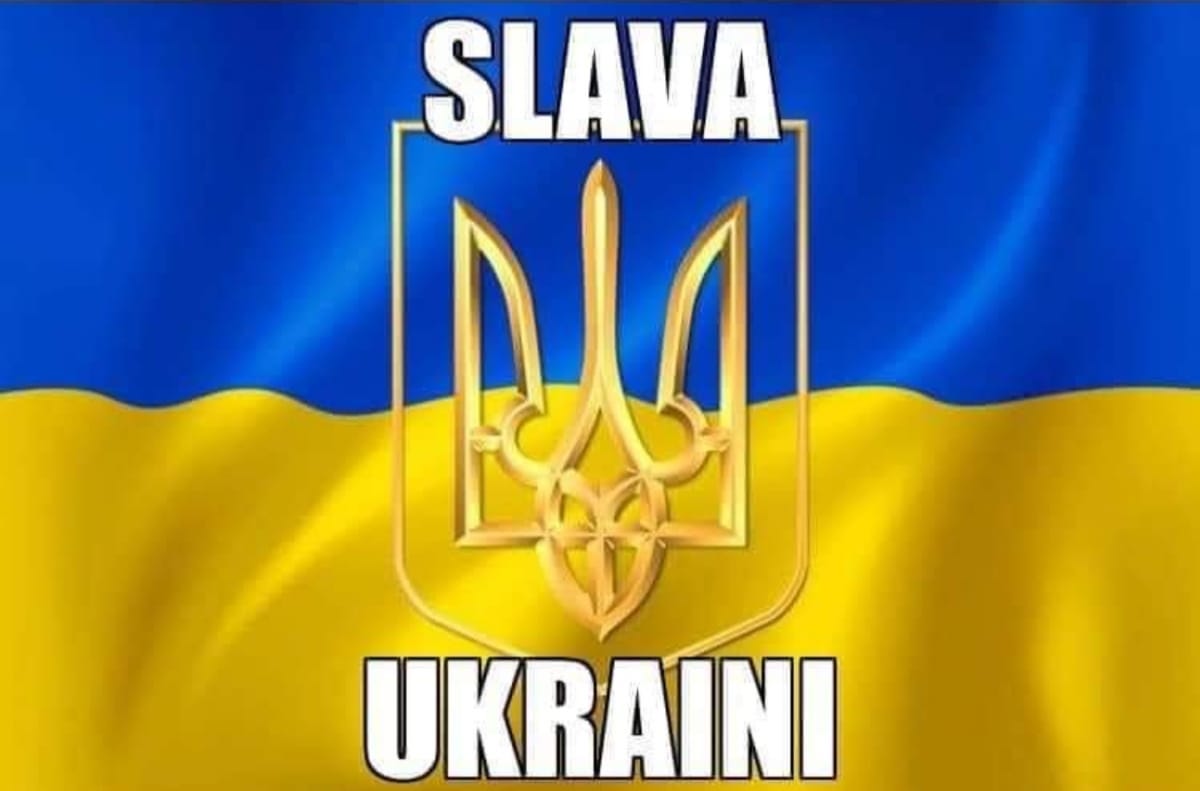Slava Ukraini! In early 2022 I began a Telegram channel aggregating news from a number of sources daily on the war in Ukraine. Since June 2023 I have provided a daily draft for the Ukraine War Brief Podcast collecting news from over 70 sources daily, much of which forms the basis of the script. While the Podcast is on hiatus I will make this Draft available here both on my own Substack and The People’s Media for those who wish to keep up with events on a daily basis.
Announcement - beginning this week and going forward, I will suspend publishing of the Draft on Sundays - Casualty figures and any major news will be reported in Mondays edition.
ALONG THE CONTACT LINE
GSAFU Morning Report
The General Staff of the Armed Forces of Ukraine in its Operational Information update at 22:00 on Aug 16 stated that day 995 of the full-scale invasion of the Russian Federation against Ukraine was about to begin.
During the past day, 99 combat engagements took place. Over the past 24 hours, the enemy carried out 5 missile strikes, 56 air strikes, 687 drone strikes and 3,371 artillery strikes across the positions of Ukrainian forces.
At the same time, Ukrainian soldiers continue to inflict losses in manpower and equipment on the occupying troops, exhausting the enemy along the entire front line and continue to disrupt the plans of Russian occupiers to advance deep into the territory of Ukraine.
Air Force Daily Report
On the night of August 17, 2024, Russian troops attacked the city of Sumy with an Iskander-K cruise missile (launched from the Voronezh region - Russian Federation) and 14 attack UAVs of the "Shahed" type from the Primorsko-Akhtarsk, Yeisk, Kursk regions - Russian Federation
All 14 Shaheds were shot down by the calculations of mobile fire groups of the Defense Forces of Ukraine, aviation, anti-aircraft missile units and EW means of the Air Force. Anti-aircraft defence worked in the Mykolaiv, Cherkasy, Poltava, Dnipropetrovsk, Zaporizhia and Kyiv regions.
The Russian Border Incursion
Ukraine continues to advance inside Kursk
The Institute for the Study of War (ISW), a US based think tank, in its Aug 16 Russian Offensive Campaign Assessment assessed that Ukrainian forces continued to marginally advance southeast of Sudzha on August 16 amid continued Ukrainian operations in Kursk Oblast.
Russian milbloggers claimed that Ukrainian forces advanced east of Mirny and south of Spalnoye (both southeast of Sudzha), and geolocated imagery published on August 15 indicates that Ukrainian forces recently operated within Borki (southeast of Sudzha).
Russian milbloggers noted that small Ukrainian mobile groups continued limited assaults behind the existing line of contact in Kursk Oblast and that Ukrainian forces continued assaults near Korenevo and west of Snagost (south of Korenevo).
Geolocated footage published on August 15 and 16 indicates that Ukrainian forces continue to operate throughout the maximalist claimed limit of Ukrainian advances within Kursk Oblast, including near Sudzha.
Ukraine continues to advance to the east towards Belgorod
The Institute for the Study of War (ISW), a US based think tank, in its Aug 16 Russian Offensive Campaign Assessment assessed that Ukrainian forces reportedly advanced further into western Belgorod Oblast during recent cross-border assaults than previously reported, but available open-source reporting and evidence indicates that Ukrainian forces no longer maintain positions within Belgorod Oblast as of August 16.
The Washington Post reported on August 15 that Ukrainian personnel who participated in cross-border assaults into Belgorod Oblast stated that Ukrainian groups conducted mechanised assaults near the Kolotilovka border checkpoint (on the international border northwest of Belgorod City) on August 11 and advanced up to roughly 10 kilometres in the area.
Russian sources claimed that Ukrainian forces repeatedly attacked near Kolotilovka in recent days and temporarily seized the Kolotilovka checkpoint on August 15 but did not claim that Ukrainian forces advanced anywhere close to 10 kilometres beyond the checkpoint.
The Washington Post reported that Ukrainian forces held positions within Belgorod Oblast while under heavy Russian airstrikes and artillery fire and that Ukrainian armoured vehicles crossed into Belgorod Oblast to evacuate remaining Ukrainian personnel from these positions on August 15.
Ukraine destroys 2 bridges in Kursk Oblast.
The Institute for the Study of War (ISW), a US based think tank, in its Aug 16 Russian Offensive Campaign Assessment stated that Ukrainian strikes reportedly destroyed two bridges in Glushkovo Raion, Kursk Oblast. Russian sources claimed on August 16 that Ukrainian HIMARS strikes destroyed bridges in Glushkovo and Zvannoye (both southwest of Korenevo).
Geolocated footage published on August 16 shows that the bridge in Glushkovo collapsed following the strike.[8] Russian milbloggers claimed that the destruction of the bridge will complicate Russian ground lines of communication (GLOCs) in the area.
Ukrainian forces 'strengthen' their positions in Kursk Oblast, Syrskyi says
Ukrainian forces have "strengthened" their positions in Russia's Kursk Oblast as their operation in the Russian region continues, Commander-in-Chief Oleksandr Syrskyi reported to President Volodymyr Zelensky on Aug. 17. The Kyiv Independent reports.
Less than two weeks into Ukraine's cross-border offensive in Russia's Kursk Oblast, Ukrainian troops control about 1,000 square kilometres of Russian territory and over 80 settlements in the region while continuing to advance, according to the Ukrainian military.
Ukrainian soldiers have expanded the "stabilised territory," Zelensky said, without elaborating. More Russian soldiers have also been taken prisoner over the past day, he added.
"I thank all the soldiers and commanders who capture Russian soldiers and thus bring the release of our soldiers and civilians held by Russia closer," Zelensky said.
Kyiv said that rather than capturing Russian territory, the incursion aims to protect Ukrainian lives by preventing cross-border attacks and diverting Russian reinforcements.
Despite mounting reports that Russia is moving at least some forces to the sector, Kyiv's troops in the east of Ukraine say the situation there remains dire as Moscow continues its advance near Pokrovsk and Toretsk.
The Khortytsia operational-strategic group
(Responsible for the northeastern part of Ukraine. )
Kharkiv axis: There were 9 Russian attacks over the last day near Lyptsi and Vovchansk, 2 attacks are ongoing.
Kupyansk axis: The enemy carried out 10 attacks against Ukrainian positions near Sinkivka, Hlushkivka, Kruhlyaivka and Andriivka. 3 engagements are still ongoing.
Lyman axis: Russia attacked 6 times unsuccessfully in the direction of settlements of Makiivka, Nevske and Terny.
Siversk axis: Russian forces carried out 7 unsuccessful assaults in the vicinity of Verkhnokamianske, Sprine and Pereizne.
Kramatorsk axis: Russian forces carried out 3 offensive actions near Hryhorivka and Chasiv Yar. 1 attack continues.
Toretsk axis: There have been 11 Russian attacks over that last day with air support. All the efforts of the enemy were directed to the areas of Dyliivka, Toretsk, Pivinchne, Zalizne, Nelipivka and Nui-York. 1 battle continues.
The Tavria operational-strategic group
(Responsible for the central-eastern and southeastern part of Ukraine.)
Pokrovsk axis: The greatest activity of the enemy today occurred in the Pokrovsk sector. The enemy conducted 37 attacks against Ukrainian defences in this area over the last day concentrating in the vicinity of Panteleimonivka, Zelene Pole, Vozdvizhenka, Hrodivka, Ivanivka, Novohrodivka, Zhelanne, Novozhelanne and Ptyche 9 battles continue.
Kurakhove axis: Russian forces unsuccessfully tried to advance 10 times in the area of settlements Krasnohorivka and Kostiantinivka.
Vremivka axis: The situation in this sector has not changed significantly.
Orikhiv axis: The situation in this sector has not changed significantly. 1 enemy attack was repulsed over the last day in the vicinity of Mala Tokmachka
The Odesa operational-strategic group
(Responsible for Kherson, Qırım, (also known as Crimea) and the Black Sea.)
Prydniprovsk axis: In this sector, over the last day, the situation has not changed significantly. Russian forces made 3 unsuccessful attempts to force Ukrainian units from their positions on the left bank of the Dnipro.
TEMPORARILY OCCUPIED TERRITORIES
Nothing to report.
THE HOME FRONT
Russian strikes downtown Sumy
Sumy Oblast Military Administration reported that the Russians launched a missile attack on the civilian infrastructure in Sumy on the morning of 17 August.
Dmytro Drozdenko, Head of Sumy City Military Administration, reported that the area of Svobody Avenue in Sumy has been struck. He noted that all relevant services are responding.
"The search for those affected continues; so far, one person has been provided with assistance. An operational headquarters for dealing with the aftermath [of the attack] is being deployed." Drozdenko said.
Russians hit apartment building and gas pipeline in Kramatorsk
A Russian strike destroyed a residential building in the city of Kramatorsk in Donetsk Oblast on 17 August, and a person was being rescued from under the rubble. Oleksandr Honcharenko, the Head of Kramatorsk City Military Administration reported on Aug 17.
Donetsk Oblast Military Administration reported that one of the Smerch MLRS rockets hit a two-storey residential building, while the other rockets hit the industrial area. The debris damaged a gas pipeline.
Kramatorsk City Council clarified that the attack on Kramatorsk left 310 customers without gas (178 apartments and 132 private households).
"A search and rescue operation is underway, and a person who was injured is being recovered from under the collapsed structures." Honcharenko said.
RUSSIAN WORLD
Nothing to report.
NEWS WORLDWIDE
US blocks Ukraine from firing British missiles into Russia
The U.K. government asked the U.S. over a month ago for permission for Ukraine to use British Storm Shadow missiles inside Russia but is yet to receive a positive response, The Times reported on Aug. 16, citing undisclosed government sources.
Ukraine has long been asking its Western partners for permission to use long-range missiles, like the Storm Shadow of American ATAMCS, inside Russia.
So far, the Western countries have not budged on the issue, even as Kyiv launched a cross-border incursion into Russia.
One British government source told The Times that the request has been effectively "stuck in their (U.S.) system," while another called it a "routine U.S. process." A third source said the discussion with allies on using the Storm Shadow is ongoing.
According to one of the sources, London does not blame Washington for the delay and considers it an expected part of a policy change process.
Solomiia Bobrovska, a Ukrainian MP, said that Russian gains made on the eastern front since the start of this year could have been stopped had Ukraine been able to use these weapons to destroy military and logistics targets deep behind the frontlines.
The story did not specify why the use of Storm Shadow, a cruise missile co-developed by the U.K. and France with a range of 250 kilometers (150 miles), would be contingent on Washington's approval.
Matthew Palmer, a U.S. charge d'affaires to the U.K., denied for Times Radio that his government would have a say in the matter.
Earlier media reports indicate, however, that the permission is not solely dependent on London. British official sources told the Telegraph in July that such a step would require an agreement among three countries, including the U.K.
Though the sources did not name the other two countries, France is a likely candidate as it produces its own variants of Storm Shadow called SCALP/T, which have also been supplied to Ukraine.
The latest news could indicate that the U.S., the leading force in the pro-Kyiv coalition and the most powerful NATO member, may also be one of the three nations.
US oil group expands in Russia as Western rivals leave
The Texas-based oilfield services company SLB is expanding its operations in Russia, filling the vacancy left by Western competitors, the Financial Times (FT) reported on Aug. 15.
SLB, the Houston-based company formerly known as Schlumberger, is the world's largest offshore drilling company. It continued to operate in Russia after the full-scale invasion of Ukraine in 2022, even as other oil giants left the country. SLB has signed new contracts and recruited hundreds of staff in the country even after its two largest US rivals Baker Hughes and Halliburton both sold their Russian businesses to local managers in 2022.
Documents obtained by non-profit group Global Witness and seen by the Financial Times show that in December SLB’s Russian business signed a contract with the Russian oil and gas institute Vnigni, which commits the company to help it build models of oil and gas deposits that can be used to develop projects.
The FT has identified more than 1,000 job advertisements posted by the company since December, seeking roles that range from drivers to chemists and geologists. Benefits on offer range from lunch at work and access to sports facilities to participation in discounted share schemes.
SLB has been upfront that it has no plans to leave Russia. But in July 2023 the company said it was “halting shipments of products and technology into Russia from all SLB facilities worldwide in response to the continued expansion of international sanctions”.
But filings show the company also continued to import materials from other sources, bringing in $17.5mn of equipment between August and December 2023, the most recent date of available records. Of this, $2.2mn was declared as having been originally manufactured by SLB or its subsidiaries.
Human rights groups and the Ukrainian government allege SLB’s work in the country helps to generate billions of dollars of oil revenues to support the Kremlin’s war effort. Last year, Ukraine’s National Agency on Corruption Prevention (NACP) added SLB to an “international sponsor of war” blacklist. “Western energy firms are still free to help Russia produce oil, and to help fund the war,” said Lela Stanley, a senior investigator for Global Witness, which is set to issue a report on SLB on Friday. “That’s a profound failure.”
A Treasury spokesperson told the FT: “The United States and an international coalition opposing Russia remain committed to reducing [Vladimir] Putin’s profits. At the same time, simply aiming to stop the flow of Russian oil would have serious consequences for the global economy.”
MILITARY & TECH
Germany is set to deliver a new package of military equipment and munitions to Ukraine by December 2024, reflecting a continued commitment to supporting Ukraine’s defence efforts against Russian aggression. Defence Blog reports.
The upcoming shipments will include a range of advanced air defence systems, self-propelled artillery, tanks, and other crucial military assets.
2 IRIS-T SLS air defense systems: These short-range air defense systems will complement the IRIS-T SLM units, providing layered defense capabilities.
10 Gepard self-propelled anti-aircraft guns: The Gepard systems will enhance Ukraine’s ability to counter low-flying threats, particularly the increasing number of Russian reconnaissance drones that have flooded Ukrainian airspace.
12 PzH 2000 155mm self-propelled howitzers: These powerful artillery pieces are known for their accuracy and long-range firepower, crucial for Ukraine’s counter-offensive operations.
4 Zuzana 155mm wheeled self-propelled howitzers: Adding mobility and firepower, these howitzers are well-suited for rapid deployment and hit-and-run tactics.
An undisclosed number of RCH 155 155mm wheeled self-propelled howitzers: Ukraine will receive these cutting-edge German artillery systems for the first time, with a contract for 54 units signed just two months ago.
30 Leopard 1A5 tanks: These tanks, although older, will significantly bolster Ukraine’s armored capabilities on the front lines.
400 armored vehicles: A broad category of vehicles intended to improve troop mobility and protection in combat zones.
Drones and counter-drone systems: Reflecting the modern battlefield’s reliance on unmanned systems, Germany’s provision of UAVs and anti-drone technologies will be key in countering Russian drone operations.
Trucks, tankers, and various transport vehicles: Essential for logistics, these vehicles will support the movement of troops, supplies, and equipment across the battlefield.
MK 556 assault rifles: These modern rifles will improve the firepower and effectiveness of Ukrainian infantry units.
Medical supplies and a field hospital: Supporting the critical need for battlefield medical care, these supplies will help treat wounded soldiers and save lives in the conflict zone.
That’s it for today’s Draft folks if you would like to keep up with events in Ukraine daily please consider subscribing, its free!
Feel free to share this update with your friends. Heroyam Slava!







